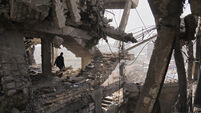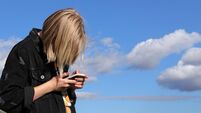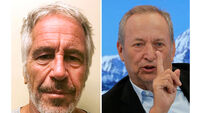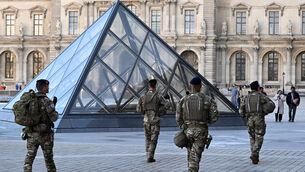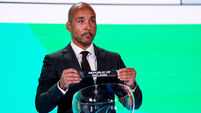DNA firm processes material from Ground Zero
The identification process on remains of those killed in the World Trade Centre attacks is continuing as more rubble is pulled from Ground Zero.
Delivery trucks hauling boxes of human specimens from New York arrive each morning at Myriad Genetics, a DNA sequencing company that volunteered to help identify the World Trade Centre dead.
The company rejigged its 12 DNA-sequencing robots to analyse samples pulled from the rubble, and offered to do the analysis at below cost, an undertaking that garnered it considerable attention.
DNA identification, rather than traditional methods such as fingerprinting and dental records, will be needed to identify most victims.
The body fragments pulled from the rubble are often too small or charred to yield anything but the tiniest specimen of DNA. Those that remain buried continue to degrade.
The sheer number of dead - around 4,400 - makes it one of history’s largest crime scenes. No government crime lab - and New York City’s is the nation’s largest - can process that many bodies.
So government officials have turned to Myriad and two other biotech companies for help in identifying the dead.
‘‘I don’t have a single adjective to describe the state of the remains. They’re dismembered, pulverised and incinerated,’’ said Brian Ward, Myriad’s vice president of operations. ‘‘There’s total chaos in the biological process.’’
Yet New York Mayor Rudolph Giuliani has vowed that every specimen will be identified and every death counted.
So Myriad shipping clerk Bob Martinez continues to unload DNA samples delivered by United Parcel Service trucks each morning. Usually there’s a few dozen vials or slides of DNA submersed in liquid inside the boxes. Sometimes there’s as many as 1,000.
The boxes also contain DNA samples to be used to match the body fragments, taken from personal items of victims and from the mouths of victims’ blood relatives.
Normally, Myriad’s sequencing are busy analysing tissue samples of women for a predisposition to breast cancer.
The company, which lost $7.1m (£4.9m) last year and has never been profitable in its 10-year history, has identified and patented two genes that when mutated greatly increase the probability of breast cancer.
Despite its dependence on DNA diagnostics, Myriad views itself as a drug discovery company.
Myriad Genetics Inc. was founded in 1991 by Nobel laureate Wally Gilbert and others to mine the records of Mormon family trees.
Earlier last month, Myriad Genetic scientists said they identified promising new targets to fight cancer and AIDS. But these successes have been overshadowed by the Trade Centre job.
Myriad’s robots, workers and computers examine and record the same 13 sequences of nucleotides - DNA’s four-letter alphabet - of each sample it receives. Excluding twins who share identical DNA sequences, the chances that two people will have the same sequences are more than a trillion to one.
Technicians drop the liquefied Trade Centre DNA into wells on small ice cube trays. Each tray is placed on one of the company’s robots, which suck up and analyse a bit of the DNA.
The results are burned onto compact disks. Myriad doesn’t make any identifications itself.
Instead it sends the raw data - the processed and numerically labelled DNA - to New York officials to make that call.
In this way, New York officials hope to identify most of the dead.
So far, eight people have been identified, indicating just how long it will take to fulfil Giuliani’s promise.
Nobody knows how many body fragments will be extracted from the rubble estimates range from 50,000 to one million. Nor has anyone publicly defined what comprises a body part.
DNA can be extracted from microscopic samples.
‘‘It’s a very noble effort and certainly means a great deal to the families,’’ said Victor Weedn, the founder of the Armed Forces DNA Identification Laboratory and now a professor at Carnegie Mellon University.
‘‘But it’s daunting. It may be impossible to test every fragment and identify everyone who died,’’ said Weedn, who in 1998 identified the remains of Vietnam War casualty Lieutenant Michael Blassie that were disinterred from the Tomb of the Unknown Soldier.
Myriad has been able to get complete results on only half of the World Trade Centre samples it analysed.
The rest are so degraded or tiny that they are beyond Myriad’s capabilities, Ward said.
That’s where Celera Genomics of Rockville, Maryland, comes in with its mitochondrial DNA testing ability.
Mitochondria are energy-producing organelles found outside the nucleus in cells. Each organelle contains DNA, making mitochondrial DNA more plentiful than nuclear DNA.
Processing mitochondrial DNA, though, takes longer and is less accurate than nuclear DNA. Even when a cell’s nucleus has degraded because of heat, pressure or time, mitochondrial DNA can sometimes be extracted.







